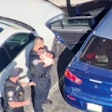Officer Tim Hanks threaded the last of the Federal Tactical 00 buck-shot shells into his Remington 870, adjusted the Beretta 92FS in his Safariland rig, touched his backup revolver, then turned to me and said, “Well, you ready to hit the street?”
I was going out with the Minneapolis Police Department’s elite Gang Task Force on an operation in the gun, drug and crime-infested Fourth Precinct on the North Side of Minneapolis, Minnesota. I was riding with Officer Tim Hanks, a close-quarter battle specialist who had just been selected for the Emergency Response Unit, Minneapolis’s SWAT team. Hanks is a former running back, an instructor in the Filipino martial art of kali, a fire-arms instructor and 220 lbs. (5% body fat, as he told me) worth of full-time weight lifter. He’s been on the bricks for over five years in some of the toughest precincts and was hand-picked, along with the other members of his unit, for the Gang Task Force. “I guess I had a reputation for doing good work, just like everybody else on this team. Everybody here is good; particularly good, at something,” Hanks said.
Strong Personalities
Lieutenant Randy Johnson, Hanks’ boss, has supervised the Gang Task Force since its inception. “My philosophy in forming this unit is to pick the very best people to do the job and then get out of their way while they do it,” Lt. Johnson says. “It’s worked very well for us. It’s not perfect; high performers have strong personalities, but it’s my job to deal with that. Their performance out on the street and the numbers they turn out speak for themselves. The diversity of this unit is one of its strengths. There’s a wide variety of experience, gender, race, language skills, tactical skills and street experience in different parts of the city and so on. Everybody on this team brings something unique to the table.”
The Task Force was formed in response to the murders of two children in drive-by shootings orchestrated by warring factions of two major street gangs. The children were innocent bystanders unconnected with gang activity. The public outcry and general outrage brought about by the deaths of 4-year-old Davisha Gillum and 11-year-old Byron Phillips prompted the city administrators to let slip the leash on their dogs of war. They sent their best officers out to target the worst of the city’s violent offenders and waited to see what happened.
On The Streets
“The way we started was to do a link analysis of all the homicides, shooting incidents and aggravated assaults,” said Lt. Johnson. “It made it quite clear, in short order, there were certain individuals and organizations that needed special attention.”
While the Gang Task Force started with one individual, it’s grown to 16 handpicked officers and three sergeants. These officers work in close partnership with the weapons unit to ensure immediate processing, at the street level, of gun violations and offenders. A close working relationship with the County District Attorney’s Prosecution Unit is key to the Task Force’s excellent record in bringing down the numbers of violent crimes. One of the most important partnerships in the Gang Task Force is that with the Bureau of Alcohol, Tobacco, and Firearms. ATF provides street-level investigative support to the police officers on the Task Force, assisting in weapons identification and tracking and other areas within their jurisdiction and expertise.
My day spent with the team is to be a multi-agency effort. The ATF, the Hennepin County Sheriff’s Department who, besides providing investigators, also provides all of the prisoner transport so as to minimize the time off the street for the Gang Unit; the St. Paul Police Department’s Gang Unit; the Minnesota State Patrol and the District Attorney’s Prosecutor’s Office all play a role. This task force packs a powerful punch right on the streets, where it’s needed most.
Accompanying Hanks and I on our tour of duty is ATF Special Agent Jim McGann. Since McGann is on-board, our unit will respond to any weapons-recovered calls so as to provide immediate, on the street processing of the weapon and to initiate tracking efforts immediately. Indeed, it doesn’t take long for those calls to roll in. We respond to assist regular patrol officers in processing seized weapons and identifying gang members. We chase one gang member down an alley and find his Tec-9 tossed up on a rooftop. We back up a Gang squad that’s just seized $4,000 in cash and several pounds of marijuana. The word gets out quick on the North Side.
“We’ll be real busy tonight, maybe tomorrow,” says Sgt. Jeff Rugel, the unit’s computer guru and database maintainer. “The bad guys’ll get the word, close up shop here, go inside or move someplace else in the city ‘till it cools off up here.” He grins. “Then we’ll show up where they’re at … again.”
Read the rest of Wynne's article in the June issue of POLICE!
Marcus Wynne is a former Federal Air Marshal who taught at the Federal Law Enforcement Training Center.















